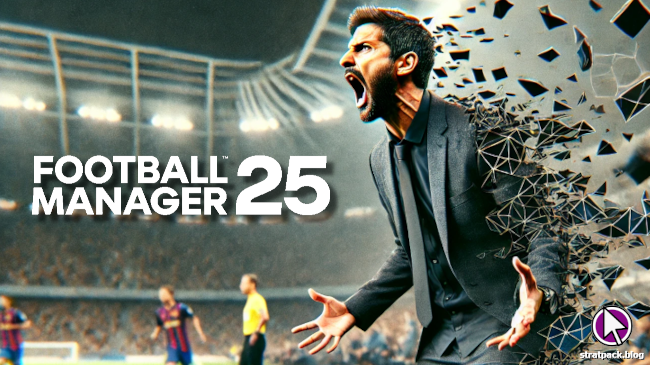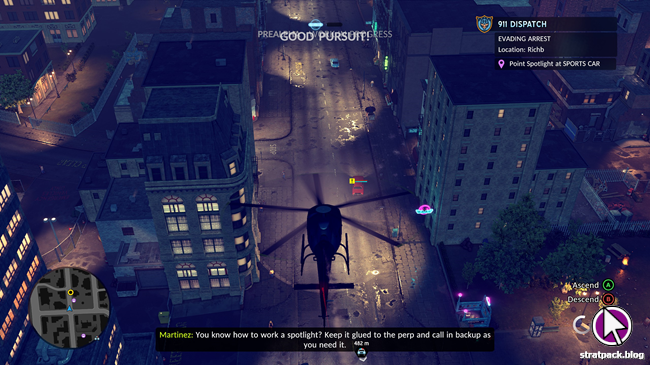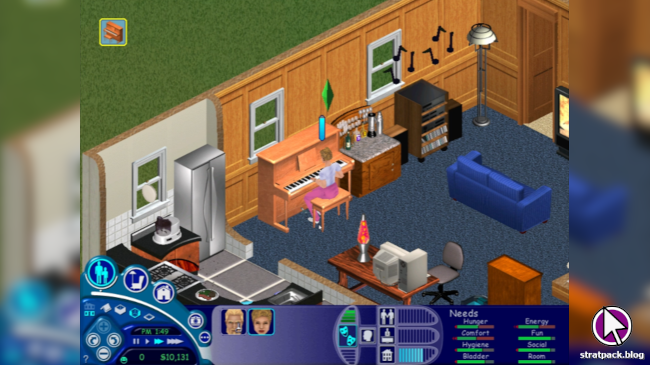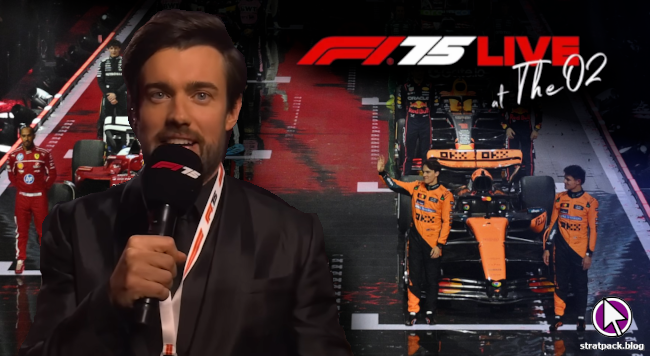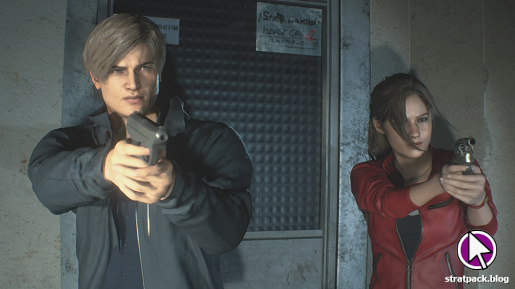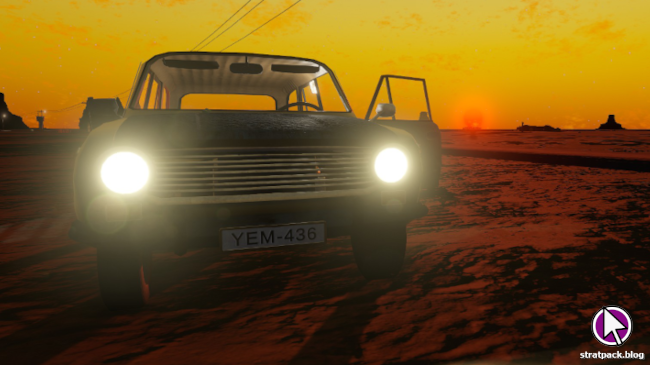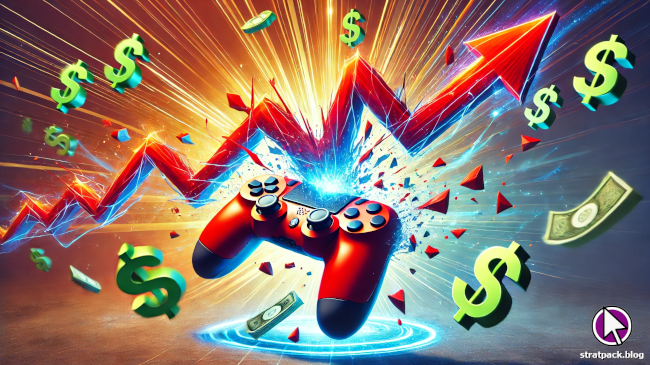
Formula 1 97 (PS1) retrospective
I was shocked on multiple levels to find that one of my favourite childhood games recently celebrated its 25th birthday. Developed by Bizarre Creations, Formula 1 97 was the official game of the 1997 Formula 1 championship, the follow-up to the 1995 original (which was simply titled Formula 1), and a disc that span in my PlayStation’s drive for hundreds of hours back in the day.
As you would expect from a licensed sports game, Formula 1 97 features all the teams and drivers from the 1997 season, with the notable exception of eventual champion Jacques Villeneuve, who was excluded for image rights reasons and is referred to simply as “the Canadian” or “Williams number one”. And as the game was released in September, the developers had time to tweak each team’s performance to match their actual performance.
Blocky but beautiful
Formula 1 97’s graphics hold up surprisingly well for a game of its age. The backdrops do suffer from some pop-in, but that can be forgiven when the recreations of the circuits are faithful enough that (save for a tweaked corner or chicane here and there) I could drive them well based on my experience with their modern-day equivalents in recent racing games.
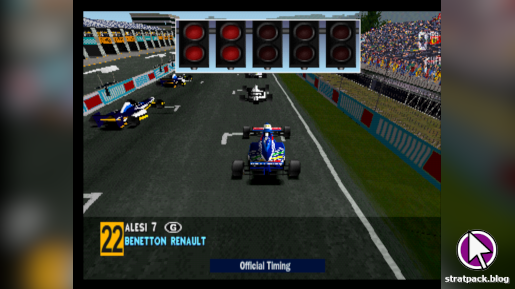
Monaco is especially well rendered. While boxy, the detail in the surroundings is massive for a PS1 game. The love that went into these circuits is apparent in tiny additions that have no business appearing in a game of this fidelity – the little Ferrari flags in the crowd at Monza, for example. The tracks also feature true-to-life sponsors, although Fosters has been censored since 1995 and the Marlboro stand-in race car has been stripped of its chevron.
The attention to detail on the cars is just as impressive, and they do have notably different bodies based on their real-life counterparts, rather than just being different textures applied to a single model, as was the norm for similar games at the time. Using the reverse camera to take a closer look is a pleasure, with liveries almost looking like pixel art renditions of the real thing.
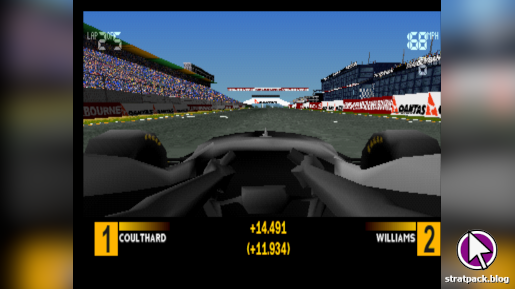
Formula 1 97 was also the first game in the series to include a cockpit view, which is of debateable utility given the draw distance, but is still a cool touch. Again, it’s the details that shine, with readable Goodyear branding on the tyres and glowing orange brake discs when you brake heavily. If you turn on tear-offs in the settings, the screen will also accumulate dirt until you hit the triangle button to rip off a visor layer – a bizarrely low-level addition.
Vroom vroom
On the audio side of things, the Grand Prix mode is soundtracked by original rock songs. They don’t quite match the original’s Joe Satriani menu track, but they do a good job of building tension and I’m not ashamed to say that at some point in the past I remember sitting down with a guitar to play along with a couple. While Grand Prix mode is the focus of this article, it’s worth noting here that the Arcade mode’s techno soundtrack is truly awful.
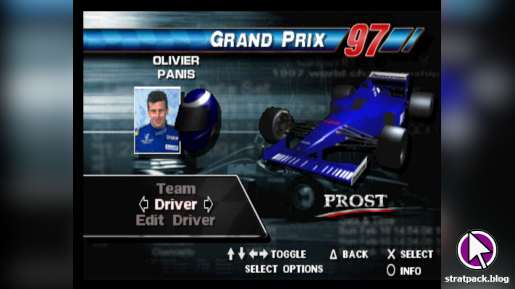
When you hit the track, the sound effects do a serviceable – if slightly drony – job of emulating the era’s V10 engines for your own car. Other cars for some reason operate at a higher pitch (perhaps to simulate perspective) and can sound like a swarm of bees at some points. Aside from that, you’ll mainly hear the cheering of the crowd and the mumble of announcers on the track speakers, but all that’s usually masked by the engine sounds.
The late great Murray Walker returns, this time joined by Martin Brundle. The commentary acts almost as a Formula 1 time capsule, as Murray gives a little intro to each circuit, noting what has changed for 1997. In-session chatter also covers regulation changes, like the implementation of a new rear crash structure, or drivers suffering from cramp due to the lower in-car position.
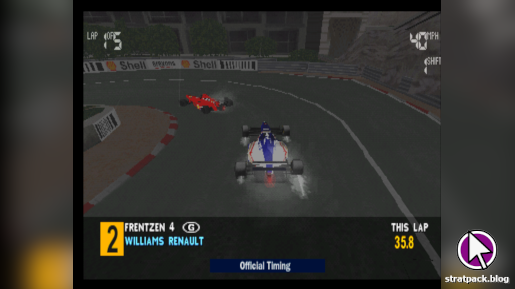
Coupled with the reactive clips for collisions and position changes, it usually does a good job of adding to the authenticity and excitement. Sometimes Murray’s clips will combine to comedic effect (“Beautiful! He’s just hit Verstappen!”), but it’s not too jarring because it somehow matches his personality. Brundle will chip in with technical perspectives, but is probably best known for responding to Walker’s remarks: “You’re right there, Murray.”
Also new for this game were race engineer radio calls. They usually occur after big collisions (“What was that?! Are you alright?”) or to guide you towards tyre changes when the weather turns. The distortion applied, likely to emulate the choppy radio of the time, means these are often incredibly loud, further adding to the adrenaline after a risky move goes wrong.
Hitting the apex
The gameplay offers some solid arcade racing – “minutes to learn, lifetime to master” stuff. The digital controls for the accelerator and brake (these were the days before triggers) mean your laps will never be as smooth as in modern games, but with circuit knowledge and careful presses you can build a satisfying flow around some corners, just grazing the edges of the track.
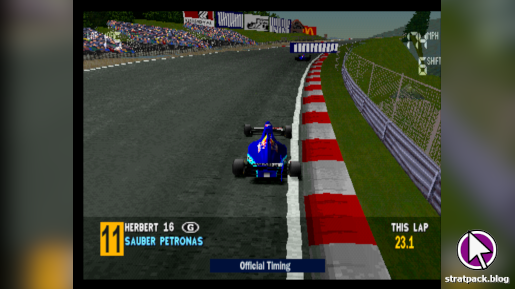
Those memory skills are important because Formula 1 97 has no HUD indicator for upcoming turns, and corners are not always visible prior to their braking zones. Interestingly, the game does offer the first implementation I can remember of a racing line, which can be set to “training” mode to highlight braking areas in red to help make things accessible for newbies.
That isn’t to say the driving can’t be punishing. Even one tyre on the grass (and there was a lot more grass and gravel close to the track in the 90s) will often result in a spin, sending you plummeting through the positions and – on the higher difficulties, at least – ruining your chances of a win. Therefore it’s often more rewarding to keep the car on the tarmac at all costs rather than pushing the limits too much, even if the latter might be faster.
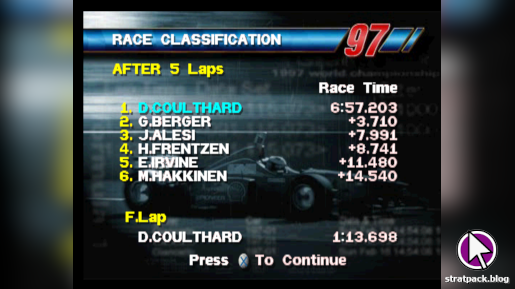
Out of interest, I looked up the real lap records for the 1997 races and compared them to my own fastest laps in the game. Generally, my laps were a few seconds quicker than the real drivers’ records. While I’d like to put that down to my immense skill, in reality it seems that the accuracy in the circuits and handling just wasn’t there yet at the time of the game’s release.
Championship rivals
Racing game AI was pretty unremarkable across the board in the PS1 era, and Formula 1 97 was no exception. It does the job, but the computer-controlled cars will mainly follow the optimal racing line (or even beyond, taking shortcuts through the barriers in some parts of Monaco). They’ll pull alongside to make their own moves, but won’t react to the player’s lunges, meaning with any move there is a risk they will turn straight into you. It’s much safer to try to get past them on the straights than in the corners.
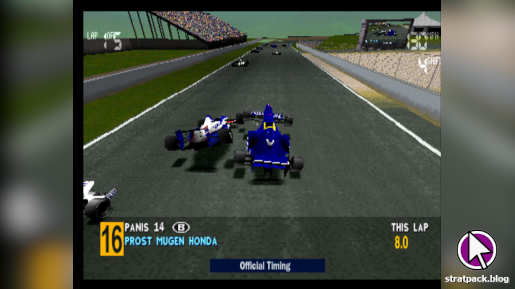
Cars are no longer immovable objects like they were in the 1995 edition, but it could be argued that Bizarre Creations went too far in the other direction. This game’s cars feel as light as a feather, leaping into the air under even moderate contact and spinning with ease – not helpful when the AI likes to behave as though you’re not even there when heading into turns.
For all its weaknesses, the AI has at least improved when it comes to the subsequent traffic jams as cars stack up behind an incident. In the original Formula 1, everyone would wait patiently for the blockage to clear, while in Formula 1 97 they weave on approach to give themselves a chance of getting through. This can lead to some wild final classifications if the leaders sit in the queue and get overtaken, adding to the entertainment factor.
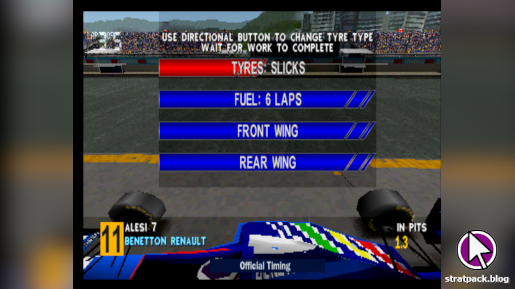
Pit stops are more of factor than before, not least because the game now has a variable weather setting, allowing for in-race transitions. Stops use a simple menu where you can choose which tyre compound to fit, which wings to repair, and how much fuel to load. Another nice little detail is that fresh tyres sport the white labels that were common at the time.
Tinkering with the setup
There are a number of additional settings to tweak to your heart’s content. Flags introduce rules while racing (and yes, it is possible to get black flagged and disqualified), and the weather setting I previously mentioned can be set to sunny, rainy, random, or the most realistic option: variable.
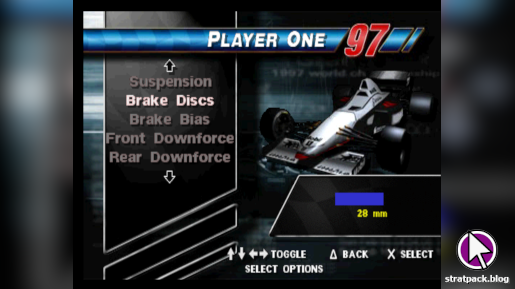
Difficulty-related settings include the main difficulty slider (with five notches) and steering/braking assists, which I never see the point of in a racing game. If you’re not steering and braking yourself, what’s the point? If you’re into the endurance and strategy side of F1, you can also crank the race length all the way up to full distance, flick on the tyre wear and fuel depletion toggles, and test your mettle in an hour-and-a-half-long slog of an event.
Formula 1 97 also gives you the option to add mechanical failures to the mix. Blown up engines were a lot more common back in the 1990s, and while it’s frustrating to lose your progress due to a random number generator, it’s rare and spectacular enough that I always liked to play with this on.
For the technically minded, there are also a few parts of the car setup that can be tweaked - the suspension, brake discs and bias, and front and rear downforce. Obviously the driving model isn’t detailed enough for this to have as realistic an effect as it would in, say, Project Cars, but it’s nice that the extra depth is there as an option for those who want to tinker.
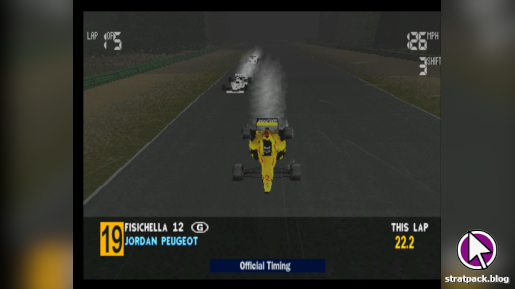
Damage, on the other hand, is a different prospect. In the previous section I mentioned how difficult it is to avoid contact with other drivers, and it doesn’t take much of said contact at all to leave you limping around the rest of the lap missing your front wing. Realistic? Yes. But when most damage accrued isn’t your fault, it’s a much happier time to play with it turned off.
It’s also worth mentioning that the driver name customisation feature - likely included so fans could rectify the Villeneuve situation - also functions as a way to input cheats. Effects include the addition of bonus tracks, a mode with Wipeout-style cars, a top-down helicopter camera, and little sprite versions of Walker and Brundle that sit at the bottom of the screen and move with the commentary. All of these are good fun to try out.
Final thoughts
When it comes to revisiting the past, video games suffer from issues that mediums like film and music don’t. While I can go back and listen to the Beatles’ songs or watch a Hitchcock movie and receive much the same experience as people would have at the time of their release, games are tied much more closely to the technology that delivers them, and therefore our modern sensibilities can render classics of yesteryear almost unplayable.
I hold up the late PS2 Pro Evolution Soccer titles as potentially the best football games ever in terms of gameplay, but I must admit that despite their lack of recent innovation, the modern Codemasters F1 games are far superior to Formula 1 97 both as entertainment products and as simulations of the complexities of what is a very technical and often convoluted sport.
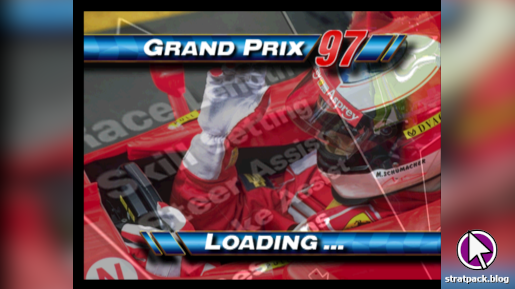
But while F1 2010 and F1 2022 might feel relatively similar, what Bizarre Creations assembled in Formula 1 97 is a slice of mid-90s Formula 1 that offers nostalgia not just for the game, but for the history of the sport. The arcade-style (by modern standards, at least) gameplay holds up just well enough to enable the game to serve as a sort of virtual history lesson.
In fact, between the details in the game (recreations of the cars, circuit layouts as they were prior to tweaks, Walker and Brundle’s comments on regulation changes) and things I Googled myself (videos of 1997 races to compare to the in-game tracks, info on long-forgotten drivers and teams, the purpose of tyre stickers), I feel like by diving back into Formula 1 97 after years away I actually learnt more about a bygone era of motorsport.
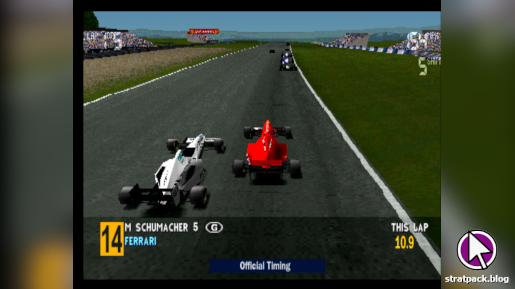
The sights, sounds, and action of classic Formula 1 are all here, and any fan of a certain age will feel warm inside listening to Murray Walker’s voice as those big yellow graphics flash on the screen and the V10s drone on. And the gameplay to backs it up, pushing the game beyond the “YouTube video search” category and making a revisit an afternoon well spent.
Unfortunately, the magic that the 1995 and 1997 editions delivered wasn’t long for this world, and development was handed to Visual Science for 1998’s game, which was widely considered inferior. Formula 1 then games entered a slump that arguably lasted until 2010. Even if there are better, more recent alternatives, I’d encourage F1 fans to at least try Formula 1 97. How many other sports games held the top spot for 13 years after release, after all?





